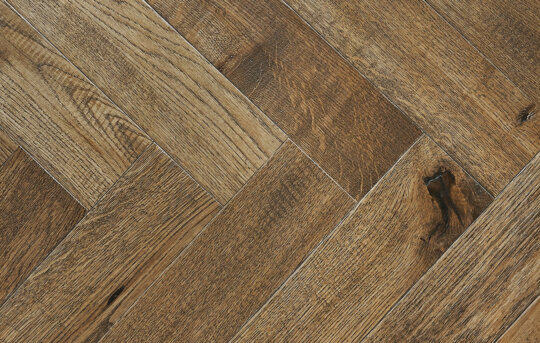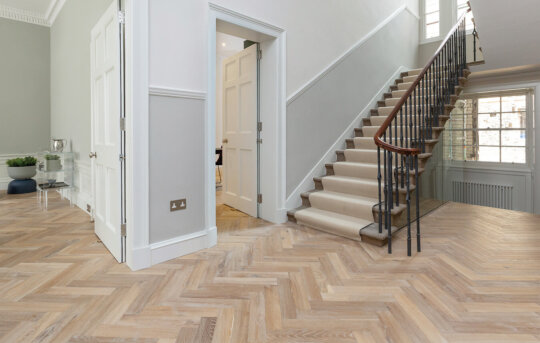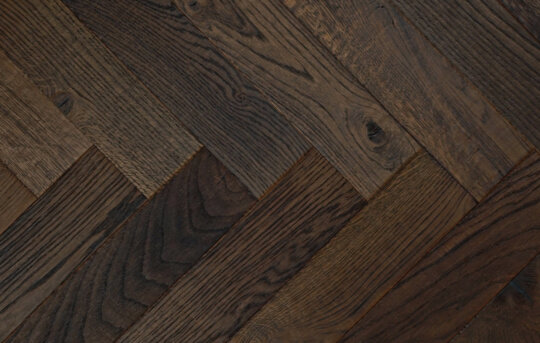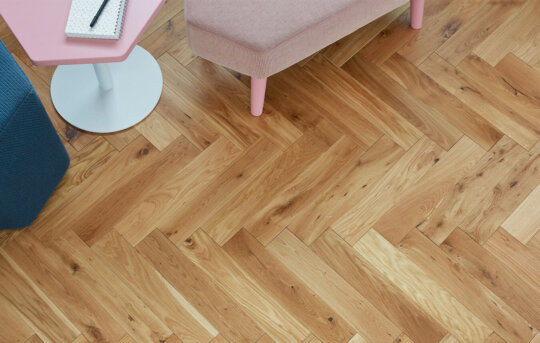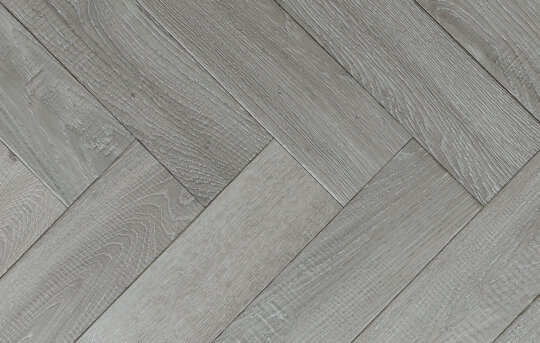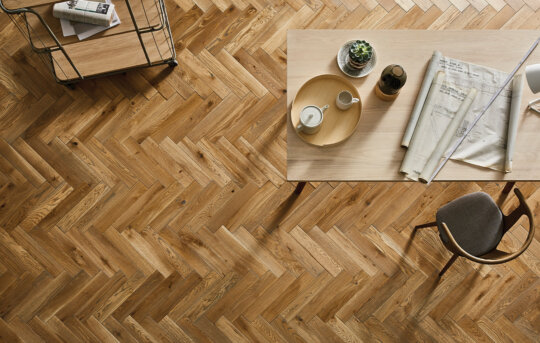Herringbone Wood Flooring
Herringbone wood flooring has a distinctive zig-zag pattern. Created from wooden floorboards cut in perfect rectangles, the blocks are staggered so the end of one board meets the side of another producing a repeated, tessellated pattern. Herringbone has forever been an enduring design. Recently in particular, there has been a resurgence in the parquet trend, with herringbone wood flooring increasing in popularity yet again. The pattern is an exciting way of introducing symmetry and balance to your home or commercial project.
We create both traditional herringbone blocks (100mm to 200mm), narrow herringbone blocks (under 100mm) and even massive oversize herringbone (starting at 200mm wide). Regardless of the scale of your project, these herringbone wood floors are an effective choice. Herringbone blocks can even be laid in up to 20 different patterns, being perhaps our most versatile wood flooring design. To learn more about these patterns, please see our blog.
PRODUCTS
Solid or Engineered Herringbone Wood Flooring?
Engineered wood flooring is made by laminating hardwood layer upon hardwood layer to create a hard-wearing plank. Solid wood flooring is made from a single piece of solid hardwood cut straight from the tree’s trunk. You can achieve similar organic and contemporary looks with these floors.
Hard-wearing
Regarding durability, engineered is less susceptible to warping and is more stable due to its construction. Moreover, if you have underfloor heating, engineered hardwood can better cope with the constant changes in temperature and will more readily transfer heat to its surface compared to solid wood.
Solid wood is a strong choice in places without underfloor heating, and due to it being lighter and less dense, is a better choice for wall and ceiling cladding.
Lifespan
Both flooring constructions will last a lifetime in the heart of your project. Many of our engineered floors come with a thick wear layer of up to 6mm. This can be re-sanded throughout the years to replenish the original look of the floor. Likewise with solid wood flooring, you can softly sand the surface through the years to return the floor to a ‘just installed’ look. Our solid floors can be anything up to 20mm in thickness, for a lifetime of usage.
Application
Solid wood flooring is incredibly versatile. Often being lighter than engineered, these floors can be used as cladding for walls, ceilings and decorative surfaces. We recommend that any of our 15mm engineered woods can also be used as wall cladding. Regardless, these woods add texture and bring a sense of nature to your surfaces.
What colour Herringbone Wood Flooring should I choose?
Herringbone Wood Flooring is available in a wide range of tones.
From light to dark, white, grey and black, you can find the perfect Herringbone flooring colour to suit your palette. Samples are available for all of these herringbone floors, and we recommend seeing them in person in order to best understand the natural variation of the wood.
White & Light
Often associated with contemporary look and clean living. White and light floors are particularly effective in residential spaces where Scandi-style and minimalist builds are desired.
Medium
Medium coloured herringbone flooring offers the best of both worlds between light and dark. The neutral and natural tones link your project to nature and provide a sense of comfort.
Dark & Black
Dark and black herringbone flooring exudes opulence. The colours are rich and indulgent, granting a feeling of luxury to spaces.
Grey
Grey wood floors are perfect for contemporary interiors; the strong and interesting colour creates a strong talking point or statement, even alongside other powerful pieces and colour palettes.
What do the different grades mean?
Wood grades indicate how many natural features a wood floor has, and they are graded according to the number and size of the features on each board, such as knots, sap and tonal variation.
Cleaner grades such as prime feature less natural variation and colour changes, whereas grades such as rustic have much more characterful difference within the floor. Consider the look you want o achieve when selecting the grade of your floor, as these changes have a huge impact on your design.
Find out more in our wood floor grades guide.
What are the different kinds of finish available?
Intelligent flooring finishes protect and enhance the surface of herringbone wood floors.
Each of our finishes has been perfectly paired to the flooring to compliment the look of the floor and ensure that your floor lasts a lifetime at the heart of your project. Both our lacquered and oiled floors give high performance, and you can easily care for these floors using the relevant Care System.
See more on wood finishes by reading our wood finishes guide.
What patterns does our Herringbone Flooring create?
Herringbone flooring has a distinctive zig-zag pattern. The blocks are staggered slightly so the end of one board meets the side of another, producing a repeated tessellated pattern.
Being the most versatile flooring design available, herringbone flooring can be laid in a multitude of patterns.
Common V-shape Herringbone patterns
- Traditional Herringbone: Laid in the traditional side-to-end fashion, this design creates a zig-zag effect across the floor.
- Herringbone with square insert: A row of traditional blocks followed by a row of squares is an exciting way of showcasing your floor.
- Double Herringbone: The same as traditional herringbone except it pairs two herringbone blocks together, adding another layer to the design.
Common rectangular Herringbone patterns:
- Block-weave basket: A classic basket weave herringbone pattern uses a ratio of four by four blocks laid together in a square. These squares are then laid in alternating directions – vertically then horizontally – to create a woven effect.
- Straight lay: The most straightforward design involves laying herringbone blocks side-by-side to create a brick-like effect across the entire floor. Great for commercial spaces.
- Chequerboard: One of our favourite plays on the herringbone is the chequerboard, which uses square blocks to create a chessboard-like effect with simple squares washing across the floor.
For more detail and a visualisation of each pattern, please read our guide to the different types of herringbone patterns.
Best rooms for Herringbone Wood Flooring
Herringbone does not need to be used in a large space to have an impact.
More repeats give the design space to breathe, showing off the edges and textures much more. These repeats also bring larger rooms together, making them feel more intimate and comforting. In smaller spaces herringbone floors do the opposite, making them feel larger and manipulating the eye.
Being an enduring design that has been effective for centuries, herringbone wood flooring is an ideal choice for both classic and contemporary builds. For a more traditional look, choose a herringbone wood floor with a more undulating texture and a hand rolled edge, and for contemporary builds, consider a sharp micro bevel edge and a lightly brushed texture.
Installing Herringbone Wood Flooring
Installing a Herringbone Wood Floor is a complex process, and should only ever be done so by an approved and certified fitter.
Most of our Ted Todd and Woodworks by Ted Todd floors are suitable for usage over underfloor heating but be sure to check any specification before proceeding.
To find out more, check out our installation guides.
How can I order free samples of Herringbone Wood Flooring?
With such a wide range of colours to choose from in herringbone, often the best place to start is by ordering free samples.
Simply put your favourite three into your basket, fill out your details and we send them direct to your door. We’ll also be in touch to help with the decision making process and assure that your flooring choice fit your project.
Alternatively, visit one of your local retail partners, or one of our Design Centres in Cheshire or London, to experience these woods first-hand.
